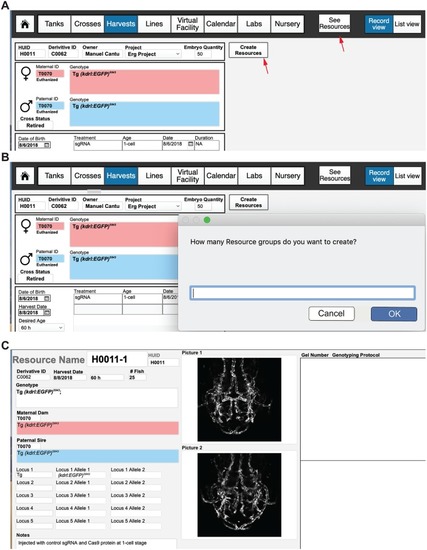- Title
-
FishNET: An automated relational database for zebrafish colony management
- Authors
- Cantu Gutierrez, A., Cantu Gutierrez, M., Rhyner, A.M., Ruiz, O.E., Eisenhoffer, G.T., Wythe, J.D.
- Source
- Full text @ PLoS Biol.
|
(A) The “Fish Lines” layout can be accessed from main layout dropdown menu, or by clicking “Fish Lines” on the main landing page (each indicated by the red arrows). (B) A new line information page can be created by selecting “New Record” (indicated by the red arrow in the header). Users can move through all records using the forward and backward arrows (top left of the header, indicated by the blue arrow). Each new record is assigned an LUID, indicated by the red arrow. This is an example of a fully annotated line record. Containers where external pictures or file attachments can be placed are indicated with an asterisk. Any tanks available for a given line will be displayed on the far-right side of the main window under the “Tanks Available” label. The tank labels are color-coded according to their age and mating status. Selecting the magnifying glass will bring up a pop-up window with a detailed overview of an individual tank (indicated by yellow arrow). Lines can also be browsed in list view (C) or compact view (D) for easy navigation, with more detailed information (TUID, tank size, number of fish, date of birth, etc.) easily available by clicking the magnifying glass icon. LUID, line unique identifier; TUID, tank unique identifier. |
|
(A) Embryo harvest template. Creating a new record in the “Harvests” layout will create a new HUID record, where information such as the cross used to produce embryos, the genotypes and TUIDs of the parents, the date of collection, and number of embryos can be entered. Information regarding any chemical or genetic treatments, the age of collection, any genotyping to perform, and downstream tissue processing can be entered into this record as well. (B) After an embryo/adult quantity is added, a user can select the “Create Resources” tab to create a unique Harvest ID (H000X-1 if one resource, 1 and 2 if two, and so on) for each embryo group or adult fish that is processed. Selecting “Create Resources” will prompt the user to select the number of groups that embryos or adults are going to be divided into. If the original embryo quantity is 50, the user could make 2 groups of 25 embryos, each with a different experimental condition. (C) Viewing the resources takes the user to an individual record view of all “resources” associated with that harvest. Information regarding genotype, tissue processing and images of the embryos can store here to create permanent records of any experimental harvest. HUID, harvest unique identifier; TUID, tank unique identifier. |


